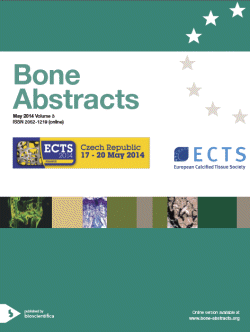
European Calcified Tissue Society Congress 2014
Prague,
Czech Republic
17 May 2014 - 20 May 2014

Oral Communications
Osteoporosis epidemiology
ba0003oc2.1 | Osteoporosis epidemiology | ECTS2014
Low serum thyrotropin level and duration of suppression as a predictor of major osteoporotic fractures – the openthyro register cohort
Abrahamsen Bo , Jorgensen Henrik L , Laulund Anne S , Nybo Mads , Brix Thomas H , Hegedus Laszlo
ba0003oc2.2 | Osteoporosis epidemiology | ECTS2014
Effect of daily vitamin B12 and folic acid supplementation on fracture incidence in elderly with an elevated plasma homocysteine level: B-PROOF, a randomized controlled trial
van Wijngaarden JP , Swart KMA , Enneman AW , Dhonukshe-Rutten RAM , van Dijk SC , Ham AC , Brouwer-Brolsma EM , van der Zwaluw NL , Sohl E , van Meurs JBJ , Zillikens MC , van Schoor NM , van der Velde N , Brug J , Uitterlinden AG , Lips P , de Groot CPGM
ba0003oc2.3 | Osteoporosis epidemiology | ECTS2014
Hip fractures in Sweden and Denmark 1987–2010 – period and cohort effects
Abrahamsen Bo , Cooper Cyrus , Bjork Jonas , Rosengren Bjorn
ba0003oc2.4 | Osteoporosis epidemiology | ECTS2014
Are the high hip fracture rates among Norwegian women explained by impaired bone material properties?
Duarte-Sosa Daysi , Vilaplana Laila , Guerri Roberto , Nogues Xavier , Diez-Perez Adolfo , Eriksen Erik Fink
ba0003oc2.5 | Osteoporosis epidemiology | ECTS2014
IGFBP1 as a predictor of hip fractures
Lundin Hans , Saaf Maria , Strender Lars-Erik , Nyren Sven , Johansson Sven-Erik , Salminen Helena
ba0003oc2.6 | Osteoporosis epidemiology | ECTS2014
Absolute fracture and mortality risk in patients with a recent non-vertebral fracture: the contribution of secondary osteoporosis or other metabolic bone disease (SECOB)
van Geel Tineke , Geusens Piet , Bours Sandrine , Wyers Caroline , van den Bergh Joop



